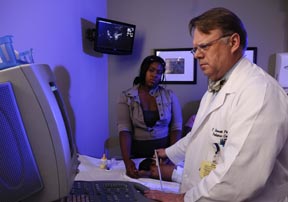Children with heart failure who receive a ventricular assist device as a bridge to heart transplant have the best chance of surviving to transplantation, according to new research from University of Alabama at Birmingham published in the Aug. 9, 2012, issue of the New England Journal of Medicine.
“For many years, adults with severe heart failure have benefitted from technological advances in the use of ventricular assist devices, better known as VADs, as a bridge to transplant,” says study co-author and UAB pediatric cardiologist F. Bennett Pearce, M.D. “However, options for mechanical circulatory support for children are limited.”
Pearce says 46 percent of children diagnosed with heart failure die or receive a heart transplant within the first five years after diagnosis. A heart transplant is a child’s best hope of survival, Pearce says, with the survival rate after a transplant estimated at 83 percent at three years. However, with limited donor hearts available, the wait is often long.
“Children on waiting lists for heart transplants experience the highest waiting-list mortality for any age or organ,” Pearce says. “This research demonstrates that the Berlin Heart, available in variety of appropriate sizes for children, has the potential to effectively and safely bridge children from diagnosis to transplantation or in some cases recovery, for long periods of time.”
| "The Berlin Heart provided better survival over longer support periods than ECMO therapy." |
In this study, Pearce and colleagues, including UAB co-author David Naftel, Ph.D., professor in the UAB Division of Cardiothoracic Surgery, compared the historical mainstay of support for children, extracorporeal membrane oxygenation therapy or ECMO, to the Berlin Heart, the only FDA-approved VAD on the market for children. The research team, known as the Berlin Heart Study Investigators, evaluated the therapies to see which offered children the best chance of survival until they could receive a new heart or recover enough heart function not to need a support device or transplant.
ECMO removes blood from the heart, pumps it through an oxygenator and returns it to the heart. Pearce says typically, ECMO can be used for 10 to 20 days before serious complications occur, including bleeding and major organ-system failure. The short support time often is inadequate for the wait time for a heart, which can be more than 100 days. As a result, only 40 to 60 percent of children on ECMO support survive long enough to undergo a heart transplant.
Seventeen pediatric cardiac centers in the United States and Canada participated in this study. The researchers divided 48 children, ages 16 and younger, who received the Berlin Heart from May 2007 to December 2010 into two groups of 24. Group one was younger and smaller; group two was older and larger. Their survival was compared to two similar groups selected from historical data in the Extracorporeal Life Support Organization registry. The ELSO registry is a multicenter, voluntary database that enrolls patients who receive ECMO support. Most of the children in the study suffered from cardiomyopathy or myocarditis, with a small portion having congenital heart disease.
The researchers found that the longest duration of support for the younger, smaller children in group one was 174 days for the Berlin Heart and 21 days for ECMO therapy. The longest duration of support for the larger, older children in group two was 192 days for the Berlin Heart and 28 days for ECMO. Overall, 88 percent of participants in group one survived to undergo a heart transplant or weaning from the Berlin Heart versus 75 percent on ECMO; 92 percent in group two survived to undergo a heart transplant or weaning from the Berlin Heart versus 67 percent on ECMO.
“The Berlin Heart provided better survival over longer support periods than ECMO therapy,” Pearce says. “These longer support periods on the Berlin Heart allow for patient rehabilitation, improved nutrition and weaning from ventilator support to use of the patient's own respiratory system so that the children may be better candidates for successful transplantation or so that long-term cardiac recovery can occur.”
Pearce says he hopes the finding of this study lead to more children with end-stage heart failure being bridged to cardiac transplantation or recovery using a ventricular assist device.
“As experience with device support accumulates, outcomes should continue to improve,” he says. “Because pediatric donors remain relatively scarce and some children with heart failure are poor transplant candidates, device therapy may become advanced enough to provide results comparable to transplantation as is being seen in adult populations.”